When you think of an at-home stationary bike in today’s fitness landscape, odds are that the Peloton Bike immediately comes to mind. However, in the realm of the best exercise bikes, the competition has caught up to the innovations and design aspects that saw Peloton literally reshape our idea of at-home training in 2020. This begs the question: Is the Peloton Bike still a worthwhile solution for indoor cycling?
From our experience with over 20 exercise bikes (including the Peloton — which some of our testers have been riding for several years) we’d venture to say that Peloton is no longer king of the indoor cycling world. Other brands offer similar resistance systems, competitive digital platforms, and innovative riding experiences that are on par with or overshadow the Peloton Bike. However, there’s still merit to this genericized cardio machine, namely in the high-quality on-demand workouts and engaged community of riders. If you’re someone who thrives in a supportive (albeit virtual) fitness environment, the “Peloton Experience” may be for you. Read on for our full Peloton Bike review.
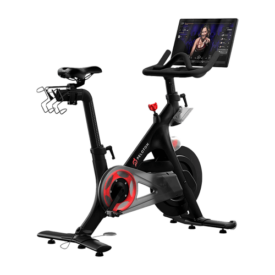
The bike that started the Peloton craze offers a 22-inch touchscreen, Bluetooth connectivity, a five-megapixel front-facing camera, and a built-in microphone. The Peloton membership offers access to thousands of live and on-demand cycling classes as well as progress tracking and leaderboards.
Main Takeaways
- The “Peloton Experience” is one of the most engaging and entertaining fitness platforms we’ve experienced, made possible by a roster of energetic, informative instructors.
- You’ll need special footwear in order to comfortably pedal through your cycling classes — the Peloton Bike features pedals designed for Delta-compatible cycling cleats.
- According to our tester, adjusting the seat and handlebar settings can be difficult at times.
Peloton Bike Specs
| Price | $1,445 |
| Product Dimensions | 59” L x 23” W x 53” H |
| Product Weight | 135lbs |
| Weight Capacity | 297lbs |
| Height Capacity | 6’4” |
| Resistance Type | Magnetic |
| Flywheel Weight | 38lbs |
| Display | 21.5” HD touchscreen |
The original Peloton Bike features a footprint measuring 59 inches in length and 23 inches in width — or 9.42 square feet. For reference, that’s smaller than your typical loveseat, which carries a footprint of 15.31 square feet. (1) “This bike is relatively small, with a sleek matte black finish — it doesn’t stick out like a sore thumb in your living room,” says one of our testers, a certified personal trainer, who did six workouts on the bike.
The reasonable footprint is ideal for athletes tight on space, but according to the brand, you may want to extend your planned dimensions. Peloton recommends an extra 24 inches on all sides of the Bike to make getting into and out of the saddle as easy as possible. However, we’ve found that these recommendations are just that — recommendations.
In terms of weight, the Peloton Bike clocks in at 135 pounds. While that may seem heavy at first glance, our tester says that maneuvering this cardio machine into place was easy thanks to the included wheels across the front base. Plus, most of the weight is stationed near the flywheel and display, so once you get the backend off the ground, it can be easy to move.
Speaking of the display, the Peloton Bike features a 21.5-inch 1080p HD touchscreen, which can provide clean and crisp visuals for all your Peloton workouts. Our tester appreciated the layout of the tracked metrics during training, too, as well as the leaderboard at the side that offered a unique sense of motivation. “The classes and the community are my favorite aspects of this bike, and the screen just helps you really dial into that,” says another tester, a Cross Fit Level-1 coach, who has done almost 200 workouts on Peloton.
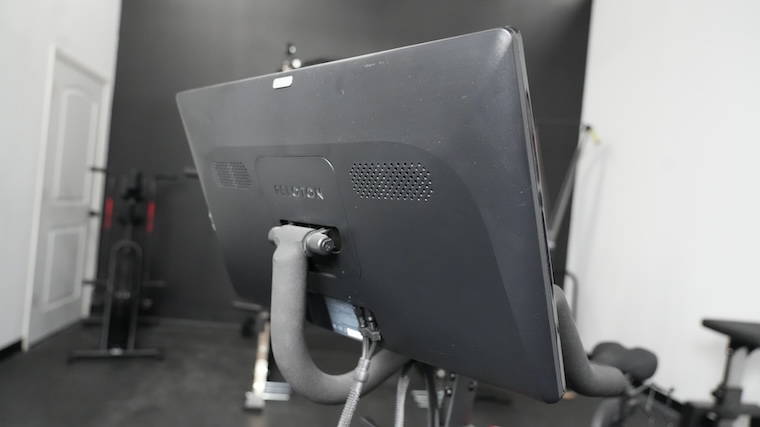
The display module also boasts two rear-facing stereo speakers that deliver your playlists and instructor’s callouts forward instead of right in your face, as well as a front-facing camera that can be used for tandem rides with your friends and family. It can also be used when you need to reach out to Peloton’s support team for any issues that pop up with your equipment. Admittedly, though, we’ve found that the camera quality is lacking, so we haven’t used the embedded tech very often.
Moving back toward the saddle, the Peloton Bike features vertical adjustments for the bullhorn-style handlebars and both horizontal and vertical adjustments for the seat. While the seat settings can help you achieve a comfortable riding experience, we do wish that the same X- and Y-axis adjustments were available across the handlebars (more on that later).
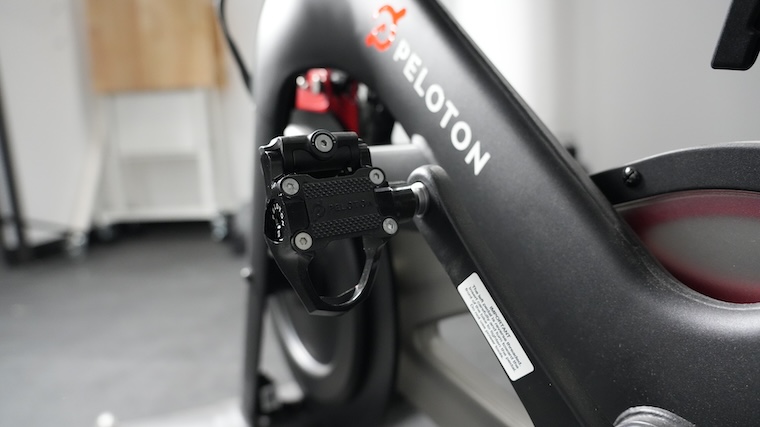
The pedals are also a component of note with this stationary bike. Unlike other bikes we’ve tested that feature a toe cage for better foot security, the Peloton Bike features Delta pedals that require compatible footwear. These Delta-compatible cycling cleats can help you improve your power and cycling economy as your foot placement never changes throughout your strokes. (2) That said, this is an extra expense — Peloton offers compatible cycling shoes starting at $125.
[Related: Best Exercise Bikes with Virtual Courses]
Lastly, the magnetic resistance showcased across the 38-pound flywheel can make for a quiet yet challenging workout experience. The intensity is controlled through a resistance knob near the center of the Peloton Bike, which can be helpful when toggling through the 100 available resistance levels.
Who Should Use / Who Shouldn’t Use the Peloton Bike
While this bike was a pandemic-era darling, is it still a worthwhile purchase years later? Or are you better off with one of the best exercise bikes under $1,000? After years of hands-on experience with this at-home cycle, we’ve nailed down who we think would benefit from this purchase and who should look elsewhere.
Recommended for:
- Beginners looking for a wide variety of motivational, engaging classes
- Those who enjoy community competition
- Individuals who enjoy spin-style studio classes like SoulCycle
Not Recommended for:
- Serious cyclists who prefer the on-road feeling
- Those uninterested in virtual coaching or classes
- Individuals on a tight budget
Our Experience Training With the Peloton Bike
For the trial runs (err, rides) with the Original Peloton Bike, our tester logged multiple sessions with a handful of rostered instructors, getting a feel for what each brought to the table in terms of energy, motivation, and expertise. Additionally, we also looked beyond the Peloton app’s cycling sessions, taking advantage of a workout library that includes modules for strength training, HIIT, yoga, and more.
We used a multi-point methodology to rate the Peloton Bike in categories such as dynamic programming, adjustability, conveniences, and more, scoring on a scale of 1 (lowest) to 5 (highest). For further information on how we trial and test products for our online content, be sure to read the BarBend equipment testing methodology.
Engaging On-Demand Classes
While we don’t think the Peloton Bike is the greatest exercise bike on the market, the biggest reason we’d recommend this spin bike over another is the level of quality across the available live and on-demand fitness classes. Every instructor brings a unique sense of energy to the screen, and we think just about any Peloton newbie will be able to find a trainer that makes them want to tune in for a sweat session day in and day out.
“I love being able to hop from a HIIT ride to an off-bike strength class to a yoga cooldown,” says BarBend editorial member Randall Colburn, who’s been riding his Peloton Bike multiple times a week for well over 3 years. “The instructors provide motivation, allow room for adjustments, and routinely make me laugh. I would die for Denis Morton.”
Another of our testers, a certified personal trainer, often turned to live classes led by Alex Toussaint over the course of their 2-week testing period. “It’s a tough job delivering the energy required to motivate athletes virtually, but I always felt like Alex could push me through my workouts with key callouts and an inviting tone,” they say. “I also loved the shout-outs and high fives that are peppered in throughout the sessions, which can help reassure you that your progress and performance isn’t going unnoticed.”
We also rated the Peloton Bike’s dynamic programming library at a 5 out of 5 given that the workouts don’t stop at just cycling intervals. The app, one of the best fitness apps we’ve tested, gives you options for off-bike training, too, with categories including HIIT, yoga, running, strength training, and more.
Kate Meier, BarBend editorial member and certified personal trainer advises how to mix one training variety with another. “If you’re looking to pair a strength-training workout with a Peloton ride, I’d recommend lifting first, so that you’re able to give 100% to your lifts. Or, using the Peloton Bike for a short warm-up before tackling a strength-training session.”
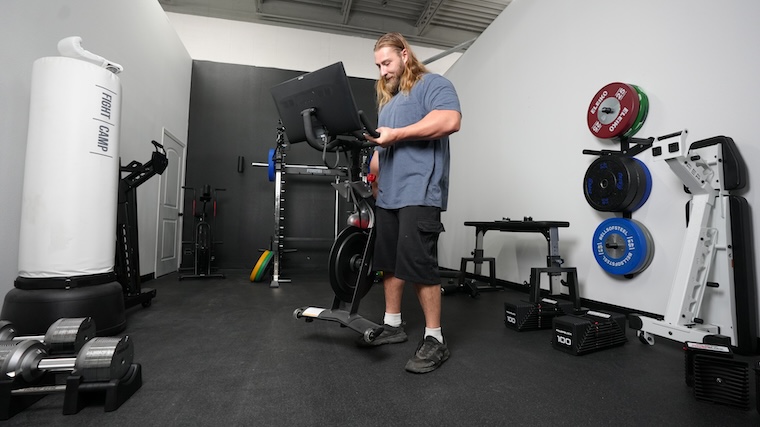
While a subscription ranges in price from $12.99 up to $44 a month, you’ll need the All-Access plan, priced at $44 a month, to access the app’s programming via the bike’s touchscreen. The less-expensive plans can only be used via a compatible mobile device.
Speaking of that touchscreen, we do wish it could rotate 360 degrees to make off-bike workouts a bit easier. That functionality, though, is only available on the pricier Bike+ model.
[Related: Peloton vs. Echelon]
Equipment Setup
While our tester had no issues regarding connectivity when getting into their Peloton classes, the same cannot be said for the more utilitarian requirements before their workouts. They noted that while the saddle adjustments were fine via the horizontal and vertical settings, they would have appreciated the same setup in regard to the handles.
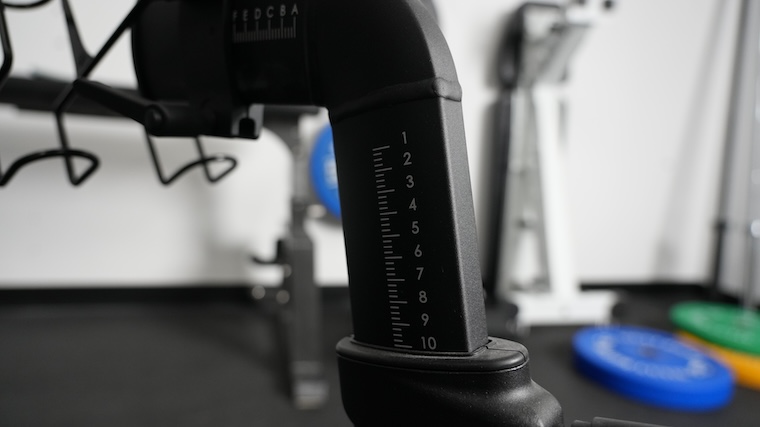
“I’ve commonly found exercise bikes offering horizontal settings for the handles, so I was surprised to see this option left off the Peloton Bike profile,” says one of our testers, who’s crushed almost 200 Peloton workouts, in relation to their 4 out of 5 adjustability rating. ”I definitely struggled to find that optimal setup at times, particularly when hopping on for a ride after my husband had just used the machine.”
In addition to the ride positioning, we also wanted to make note of the clipless pedal design. Do not expect to hop onto this Peloton Bike with even the best cross-training shoes, as the pedals are designed for cycling-specific footwear. This does mean that in order to get the most out of your engaging workout experience, you’ll need to pay a little extra for a pair of Delta-compatible cleats, which Peloton sells for $125. Speaking of add-on purchases…
Accessory Add-Ons
We rated the Peloton Bike’s included conveniences at 4 out of 5 thanks to the inclusion of dual water bottle holders at the front and dumbbell cradles underneath the saddle. However, we found that in order to get the most out of your “Peloton experience,” you’ll need to shell out a little more coin than the listed $1,445 for the exercise bike alone.
In addition to the aforementioned Delta-compatible cycling shoes, we also recommend purchasing a bike mat that sits underneath the Peloton Bike during use. This can help prevent any unwanted scuffs and scrapes across your floor, and also giving your bike a more stable platform to rest upon as you pedal through grueling sessions.
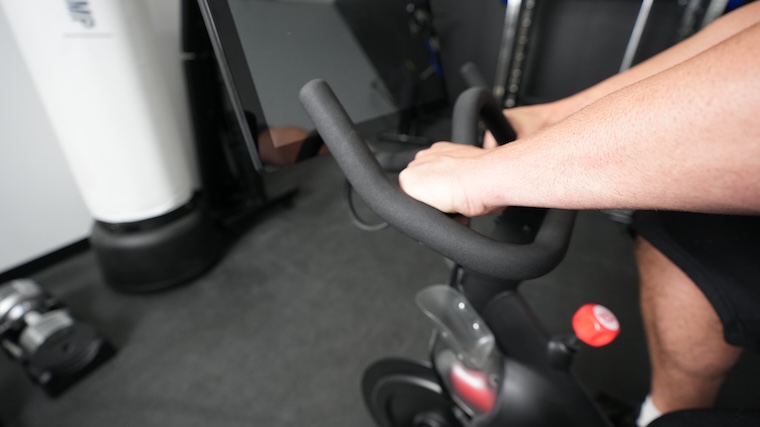
Also, if you plan on taking part in Peloton’s off-bike courses, you’ll likely need extra accessories, including a foam roller, free weights, and may we suggest, the best resistance bands — all of which are not included in the base package.
Peloton does offer bundled accessories kits to help you get started, but the packages start at $240. When you add in the cost of the original Peloton Bike and the $44 monthly charge for the All-Access membership, you could be stretching your budget further than you initially planned.
What to Consider Before Buying the Peloton Bike
“Cycling brings an impressive collection of health benefits to the table: cardiovascular health, endurance, stamina, muscular endurance are all improved with cycling, to name a few,” says certified personal trainer Amanda Capritto, one of our expert contributors. As such, there are a few considerations that need to be had before you think about adding the Peloton Bike to your home gym setup.
- Footprint: As with even the best home gym equipment, you’ll need to ensure that your available space matches the dimensions of the Peloton Bike. Be sure that your floor plan has the required 9.42 square feet of space needed to house this connected stationary bike.
- Price: You’ll want to budget more than just the $1,445 cost of the Peloton Bike. A pair of compatible cycling shoes will run you $125, and an All-Access membership — which lets you take classes via the bike’s touchscreen — costs an additional $44 per month (that’s $528 a year). And that’s not including any extra accessories you may want to purchase.
- Height and Weight Capacities: According to the brand, the Peloton Bike can support athletes up to 297 pounds and 6 feet 4 inches in height. While larger athletes may find these metrics lacking, this should indicate a sturdy enough build quality for most.
- Dynamic Programming: In addition to spin classes and scenic rides, the Peloton app’s monthly membership can cater to multiple disciplines, including boot camp workouts, strength training, HIIT workouts, yoga, and more. While Peloton offers a lot, make sure this type of trainer-led programming is what you’re looking for. There’s no need to spend the extra cash for the app if you won’t be using it.
Peloton Bike Vs the Competition
In testing over 20 different exercise bikes, we’ve found a number of different silhouettes that can make opting for at-home training a worthwhile consideration over paying for a gym membership. While we don’t think the Peloton Bike leads the category in terms of performance and value anymore, we still think it’s a strong option for some athletes. However, we wouldn’t be doing our job if we didn’t offer some alternatives, so here are three different stationary bikes we think stack up to the Peloton Bike — the Peloton Bike+, NordicTrack Commercial S22i, and Schwinn IC4.
| Peloton Bike | Peloton Bike+ | NordicTrack Commercial S22i | Schwinn IC4 | |
| Price: | $1,445 | $2,495 | $1,999 | $999 |
| Product Dimensions: | 59” L x 23” W x 53” H | 59” L x 23” W x 59” H | 61” L x 22” W x 58” H | 54.6″ L x 30.7″ W x 51.8″ H |
| Product Weight: | 135lbs | 140lbs | 205lbs | 113.6lbs |
| Weight Capacity: | 297lbs | 297lbs | 350lbs | 330lbs |
| Height Capacity: | 6’4” | 6’4” | N/A | N/A |
| Resistance Type: | Magnetic | Magnetic | Magnetic | Magnetic |
| Flywheel Weight: | 38lbs | 38lbs | 32lbs | 40lbs |
| Display: | 21.5” HD touchscreen | 23.8” HD touchscreen | 22” HD touchscreen | N/A |
One of the easiest comparisons to the Original Peloton Bike is the brand’s other cycling silhouette, the Peloton Bike+. This upgraded profile costs over $1,000 more than the base model, with the main separating feature being its larger 23.8-inch HD touchscreen. This monitor also rotates 360 degrees for better off-bike viewing, which can be ideal for cross-trainers looking to take advantage of the full Peloton workout library.
The Bike+ is also compatible with Apple’s GymKit, which can sync your workout progress to your iPhone or Apple Watch for more streamlined data monitoring. However, we don’t think a slightly larger screen and Apple integration justifies a price hike of more than $1,000. After all, the Peloton Bike is still compatible via Bluetooth with many of the best heart rate monitors, so there’s still potential for more informed training feedback.
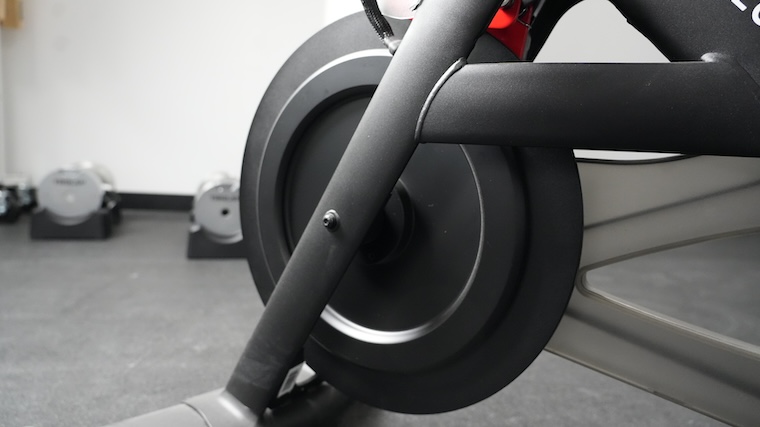
The Commercial S22i from NordicTrack is possibly the biggest challenger to Peloton’s reign. Available for roughly $500 more, this NordicTrack offering comes equipped with a larger 22-inch HD touchscreen that rotates 360 degrees for off-bike viewing. Additionally, the iFIT platform — the digital workout service compatible with NordicTrack equipment — costs $39 per month as opposed to Peloton’s $44 All-Access monthly subscription fee.
However, some may find that the iFIT instructors do not align with their training goals, so it can be a subjective debate as to which service is best for your needs.
Additionally, the NordicTrack S22i Exercise Bike features AutoAdjust technology that automatically toggles your resistance in-tune with your on-screen instructor. This can make for a more convenient workout experience that allows you to focus more on your performance than your bike’s settings. This NordicTrack offering also features both incline and decline adjustments between -10 and 20 degrees, which can better replicate on-road conditions.
Lastly, the Schwinn IC4 operates under the same quiet magnetic resistance system as the aforementioned bikes. It’s also far cheaper than the original Peloton Bike at $999. However, you do not get an integrated display with this Schwinn offering. Instead, you’ll need to bring your own device in order to stream workouts via the JRNY app.
Places to Buy the Peloton Bike
The Peloton Bike is available for purchase on the brand’s direct-to-consumer site, as well as via third-party retailers like Amazon and DICK’S Sporting Goods.
Customer Experience
The delivery window for your Peloton Bike can vary depending on how busy the brand is, which we found out firsthand after waiting nearly one month for our exercise bike to arrive. However, Peloton is offered through third-party retailers like Amazon and DICK’S Sporting Goods, so you could have a quicker experience depending on your shop of choice.
In terms of assembly, the Peloton Bike can be quick to put together — even more so if you opt for the brand’s premium delivery, in which professionals take care of the (literal) nuts and bolts. After getting your device connected to your Wi-Fi network, you can be well on your way to enjoying your trainer-led workouts.
Warranties
BarBend expert contributor Amanda Capritto, certified personal trainer, recommends paying close attention to your exercise bike’s warranty to ensure the available coverage is worthwhile. “Look for at least five years on the frame, two years on parts, and one year for labor,” she adds. Unfortunately, the package offered for the Peloton Bike is slightly below this recommended timeframe, with 5-year coverage supporting the frame and 12 months on the touchscreen, components, pedals, and labor.
Company Information
Peloton, as a brand, started in 2012 with the goal of bringing the atmosphere and community of boutique fitness classes directly into the home. While Peloton has essentially become the genericized term for any connected stationary bike with a large display, the brand also offers rowing machines, AI-powered personal trainer devices, and the Peloton treadmill — all of which are synced to the Peloton app and its thousands of live and on-demand courses which are compatible with their fitness equipment.
To reach Peloton, you can call the listed number (1-866-679-9129) or start a live chat directly on the brand’s web page. Representatives are available between 6 a.m. and 12 a.m. ET, seven days a week to answer inquiries.
In Conclusion
While Peloton may have lost its “trending” status as other companies have caught up to their offerings, the Peloton Bike can still be a suitable solution for at-home training. The app remains one of the best online workout programs we’ve tested, and the instructors are lively and motivating. Also, the machine itself is still plenty durable provided you’re not looking for automatic resistance adjustments or incline and decline settings to mimic on-road training.
In addition to the cycling aesthetic, the Peloton Bike can also be worthwhile for those interested in cross-training thanks to the Peloton app’s abundance of off-bike workouts. Granted, you’ll need to spend some cash for the required accessories and ensure your setup is within view of the non-rotating screen, but the roster of training sessions does make the monthly charge all the more digestible. Over time, innovators often get passed over, but thankfully, there’s still plenty of get-up across this innovative indoor spin bike.
FAQs
How much does the Peloton Bike cost?
You can purchase the Original Peloton Bike for $1,445 through the brand’s direct-to-consumer site, or through third-party retailers including Amazon and DICK’S Sporting Goods.
Can you use the Peloton Bike without a membership?
The Peloton Bike does feature a “Just Ride” mode that essentially turns the connected exercise bike into a manual spin bike. However, in order to reap the benefits of the “Peloton experience” and its accompanying live and on-demand workouts, you’ll need to sign up for a membership to the brand’s app.
How much is a Peloton membership?
The Peloton All-Access Membership costs between $12.99 and $44 monthly, depending on the plan.
References
- Jaramillo, C. (2022, December 29). A guide to sofa dimensions & sizes. SeatUp, LLC. https://seatup.com/blog/guide-to-sofa-dimensions/
- Lisbin, T. (2024, January 10). What is clipping in and why is it beneficial?. Ride Shimano. https://ride.shimano.com/blogs/blogs-and-news/what-is-clipping-in-and-why-is-it-beneficial-1